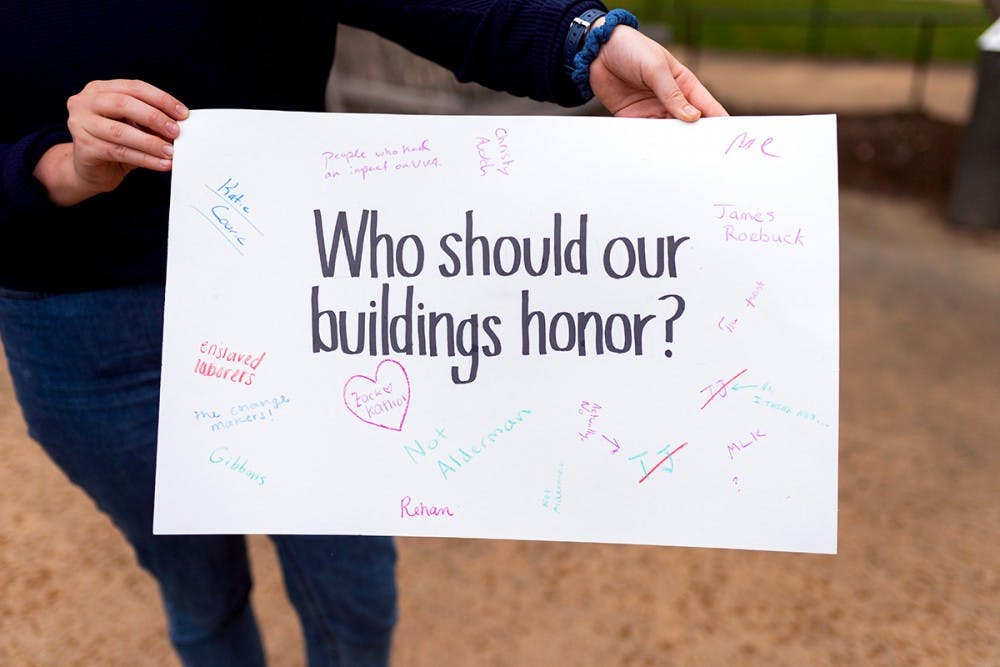The University Guide Service hosted a specialized historical tour Monday for community members surrounding the theme of building names on Grounds. The tour marked the first day of U.Va. History Week, a week of themed tours hosted by the University Guide Service. Each day of the week will host tours centered around different questions related to the University’s history. The theme for Monday’s tour was "Who should our buildings honor?"
“We're really interested in coming up with these kind of five different questions to frame all of history week,” said Sophia McCrimmon, historian for the University Guide Service and a second-year College student. “We wanted to kind of tap into the conversations that are already happening on Grounds that we feel are really related to [our] history.”
Other questions throughout the week focus on topics of student protest, the University’s relationship with the Charlottesville community, the Lawn and various monuments on Grounds.
The tours are largely a reframing of the current historical tours that are already given by the guides service, but McCrimmon says they offer a chance to expand upon specific elements of the University’s history.
“As the University Guide service, we give historic want Admissions tours pretty regularly, but often, especially for historical tours, people who are coming are not U.Va. students,” McCrimmon said. “So really what I wanted to do with this week was get more current U.Va. students engaged with our kind of shared history and learning about the … past that happened right here.”
Monday’s tour centered around controversial names of various University buildings. Many of the buildings, McCrimmon said on the tour, are simply named after prominent professors and administrators throughout the University’s history.
“A lot of these namesakes for buildings were early the professors who were here in the first few decades of history, which means that it had some connections with the institution of slavery at U.Va.,” McCrimmon said. “And that kind of connects again to this broader question of ‘to what extent is that something that we should take into consideration?’”
The tour touched upon some specific University building names and locations, such as Bonnycastle House and Emmet House, both residential buildings on McCormick road. The two professors the buildings were named after — John Emmet, a professor of natural history, and Charles Bonnycastle, a professor of philosophy and mathematics — were slave owners during their time teaching at the University in the mid-19th century.
McCrimmon also discussed the University naming the Gibbons first-year dorm after William and Isabella Gibbons, two former slaves who became prominent members of the Charlottesville community after the Civil War.
“It obviously stands out from the rest of these dorms and academic buildings because it's named after a formerly enslaved couple,” McCrimmon said. “I think that there has been a lot of appreciation of that move but also some criticism because, you know, to what extent does naming one dorm after a couple actively kind of repair, or do anything against this, like I said, overwhelming pattern of another kind of demographic, when you look at who buildings are being named after.”
Discussion of these controversial names have prompted some University officials to consider renaming some of the buildings involved. The Curry School recently formed a committee to consider potential changes to the education school’s name.
The Curry School was named in 1905 for J.L.M. Curry, an Alabama politician who advocated for succession, served in the Provisional Confederate Congress and served as an officer in the Confederate Army through the end of the Civil War. In the decades following the war, Curry became known as an educational reformer and advocate of public education.
Other buildings have also sparked controversy due to their association with the Civil War. Maury Hall was named in 1942 for Matthew Fontaine Maury, a former U.S. Navy commander who resigned his post in order to join the Confederacy.
McCrimmon also spent time on the tour discussing several University buildings which had been named for figures involved in the eugenics movement. One of those buildings, Jordan Hall, was recently renamed to honor Vivian Pinn, the first African American woman to graduate from the University’s medical school in 1967. Another, Lewis Hall of the IRC, was renamed to honor W. W. Yen, the first international student at the University.
After the tour, the University Guide Service and Second Year Council hosted a presentation and discussion in the Newcomb Gallery to touch upon many of the themes the week is centered around.
“I'm hoping that regardless of whether people even have a chance to come on the tours this week, I just wanted to put those questions out there [and] get people thinking critically about the history of this university and their connection,” McCrimmon said.
Tours will be given at 4 p.m. everyday of the week until Friday, starting on the South Side of the Rotunda.







